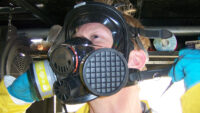Landowners fear injection of fracking waste threatens West Texas aquifers
Slideshow: Operators pump a sea of “produced water” underground for disposal. Intensifying tremors raise fears that the deep toxic waste pits could intermingle with water used for farming and drinking.

David Shifflett, a farmer in Reeves County, parses records of his protests to the Texas Railroad Commission against permits for nearby wastewater injection wells. Photos by Pu Ying Huang/The Texas Tribune
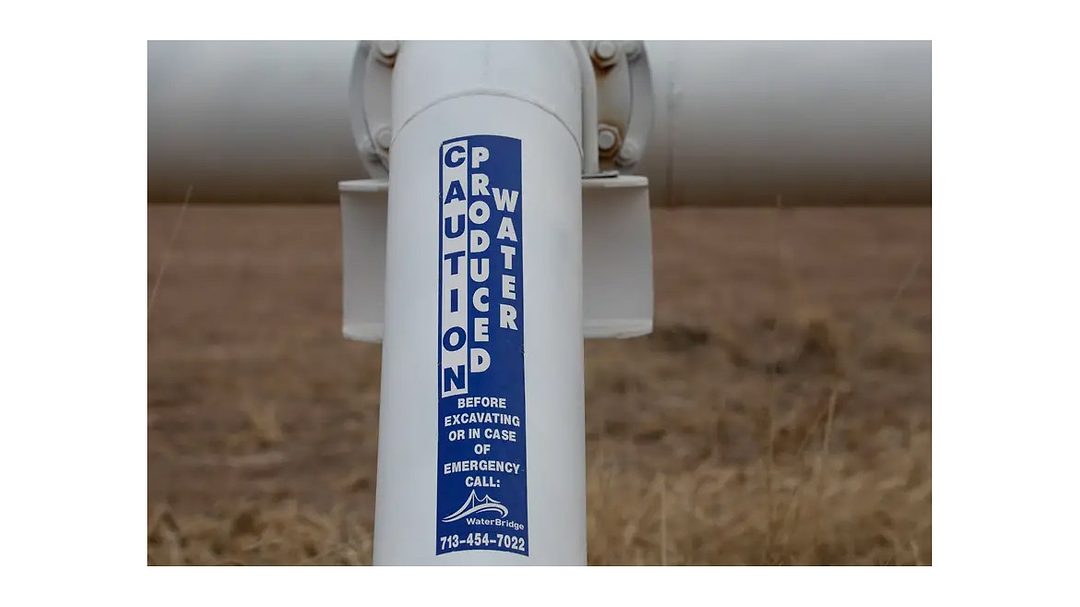
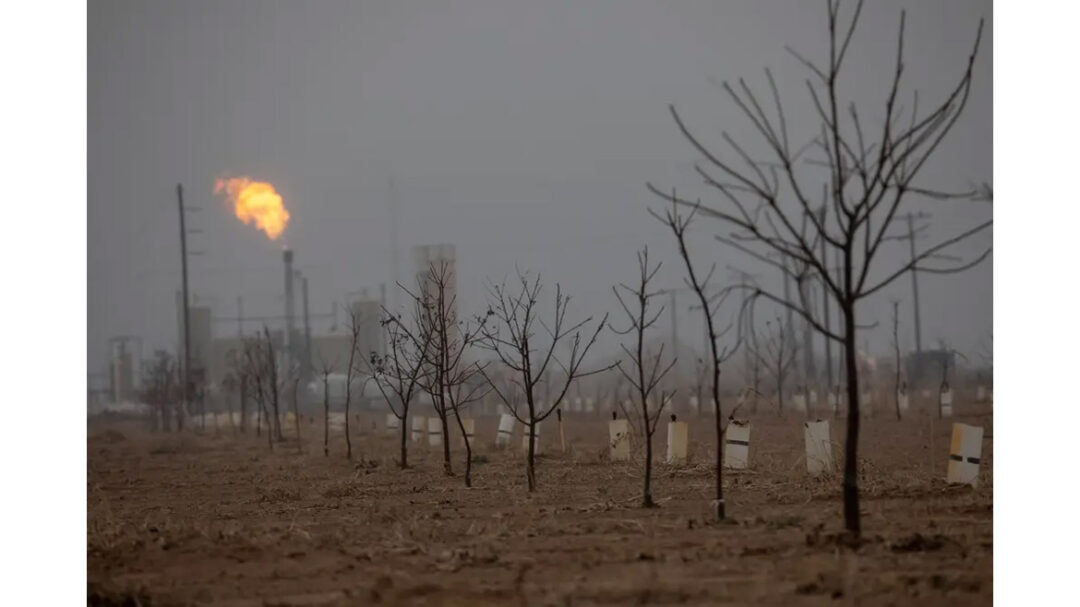
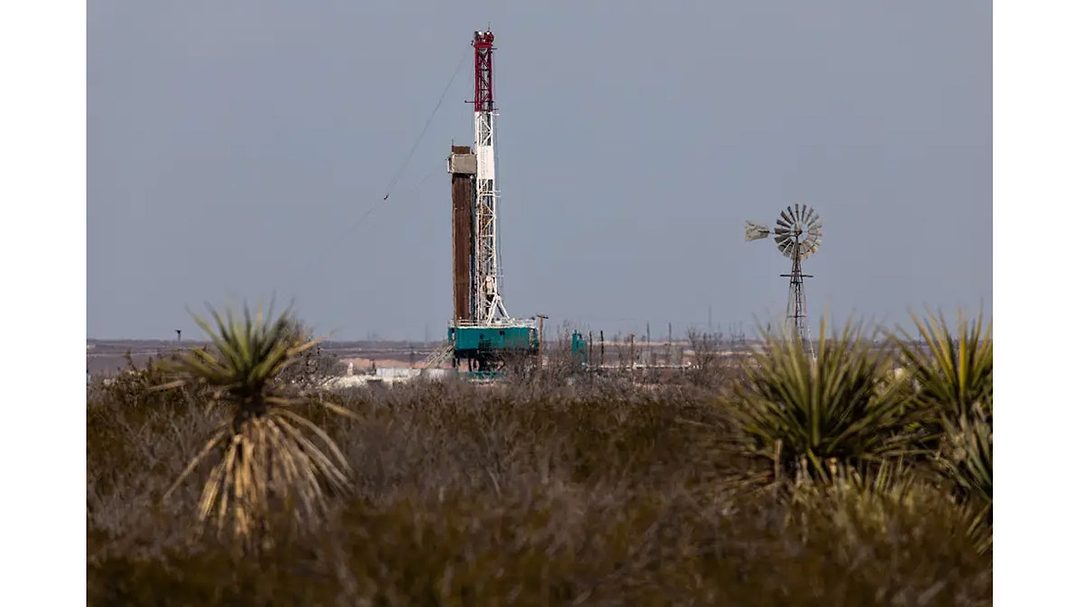
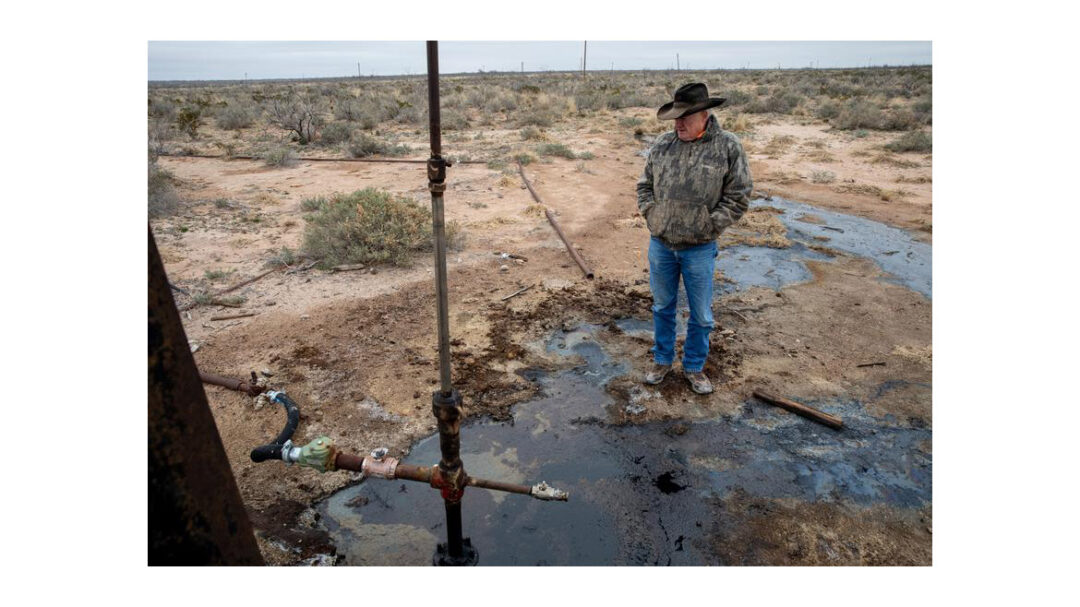
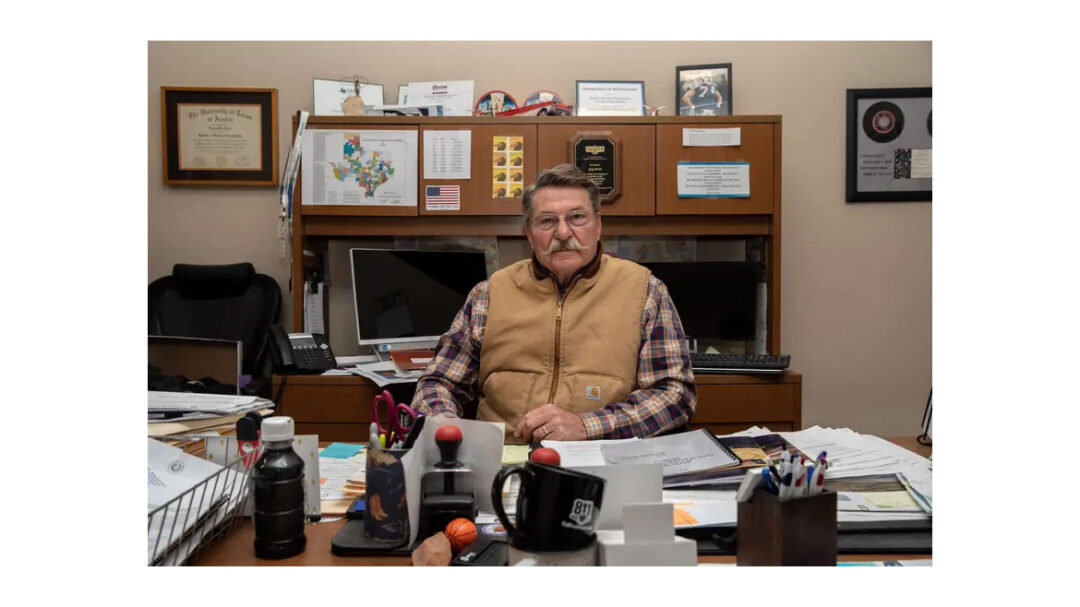
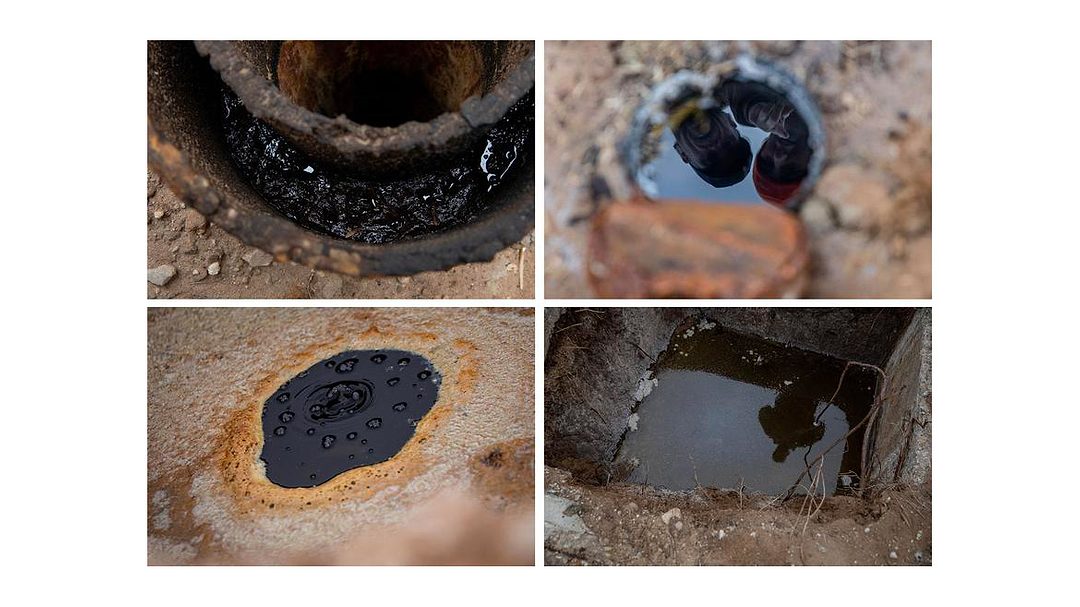
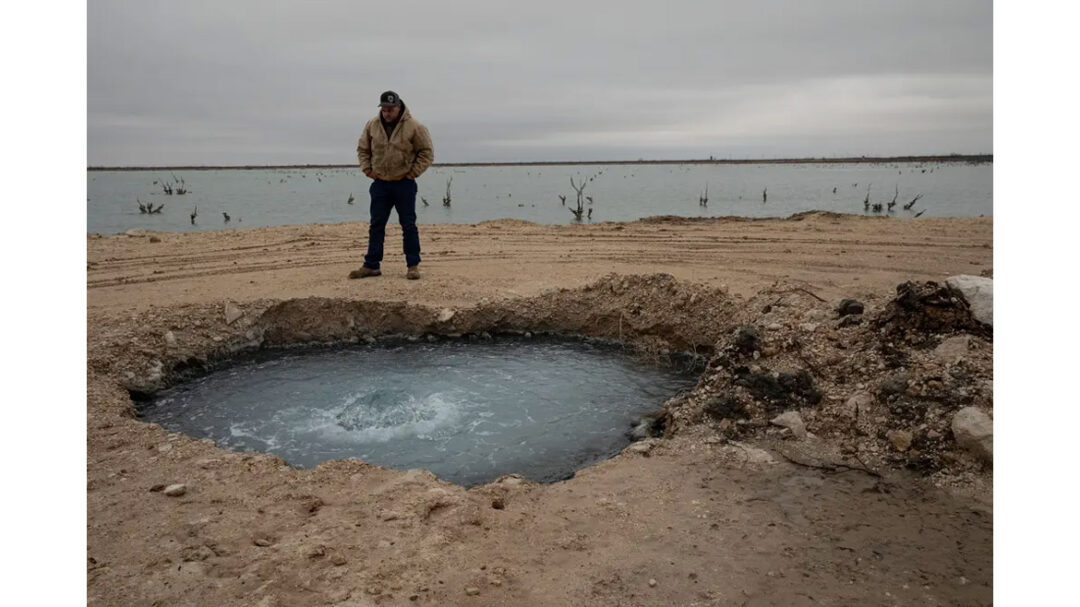
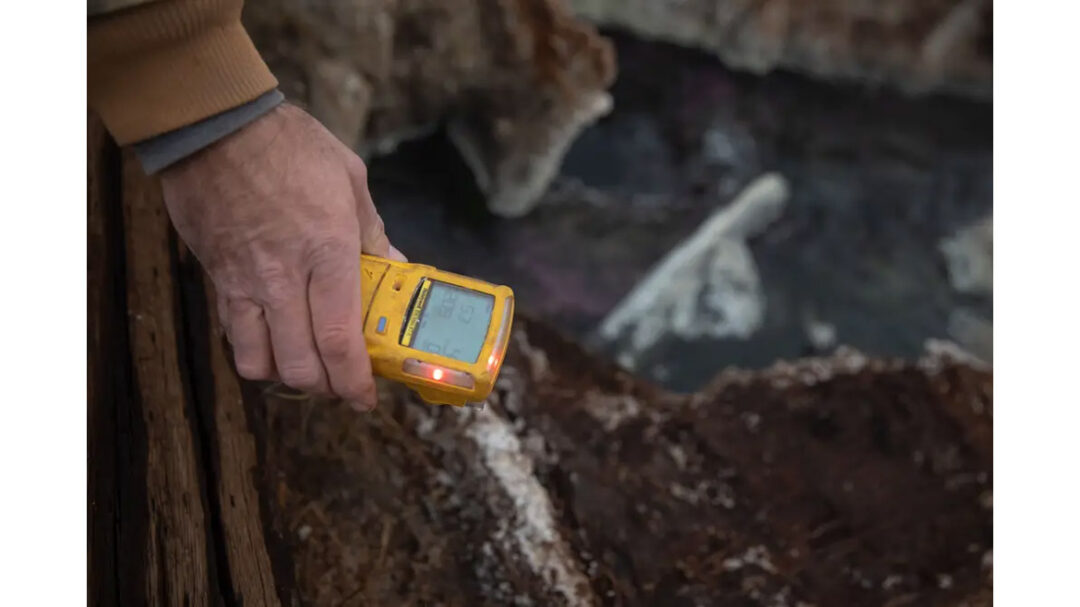
Photography by Pu Ying Huang | The Texas Tribune
A fracked well in West Texas can produce five times as much wastewater as oil. Every day, fleets of tanker trucks haul hundreds of millions of gallons of this toxic brine to loosely regulated disposal facilities that line the rural highways.
There, companies inject it deep underground into rock formations, where they hope it will stay forever.
The situation troubles David Shifflett, a farmer who irrigates his crops and draws his drinking water from the ground, which has started to heave and bulge in recent years. One tremor left a broad hump and a half-mile crevice in his land, not far from his water wells, raising fears among him and other landowners that underground storage spaces could fracture and leak their toxic contents into aquifers and wells.
“They’re pumping so much pressure in there,” said Shifflett, a towering, gray-haired man from a long line of farmers. “The oil companies are going to ruin our water.”
The fracking boom kicked off here more than a decade ago. The steady crescendo of earthquakes began a few years after. At first, Shifflett said, they sounded like shotguns in a distant field. Then they grew: a magnitude 3.5 quake in 2016 and a magnitude 5.0 quake in 2020. One of the quakes that hit late last year, a magnitude 5.4, felt like a truck hit the house.
Decades of research have linked injection wells to earthquakes, but much less is known about how the combination can affect groundwater. Although injection wells are intended to hold their contents forever and protect aquifers from contamination, oozing wells and bubbling lakes of gassy brine in a nearby part of West Texas show that things underground don’t always go according to plan.
Shifflett, 74, has nothing against oil. He votes Republican, hangs a cross above his door and leans an old rifle on his living room wall. Oil companies are doing their jobs, he said. For this situation, he blames the government — specifically, Texas’ oil field regulator, the Railroad Commission, which issues permits for fracking wastewater injection wells.
“If they ruin the water out here, there won’t be anyone left. This will be a desert with no inhabitants,” he said from his dining room table. “It’s only a matter of time.”
Injection disposal of toxic waste is a common practice for refineries and chemical plants. What sets the Permian Basin apart is the volume. As oil production surged here in recent years higher than in any other U.S. oil field, the amount of wastewater rose in step.
Every barrel of Permian oil comes up with several barrels of mucky fluid called “produced water” — mostly hypersalty water that has stewed for millions of years underground with hydrocarbons, mixed with the proprietary chemical cocktails injected by drillers to fracture shale. Millions of barrels surface every day. Some of the fluid is reused in fracking, but most is injected underground for disposal.
According to one 2020 study by the Bureau of Economic Geology at the University of Texas at Austin, the amount of produced water from the Permian Basin was over six times greater than that from other major U.S. shale plays combined. Such massive amounts of wastewater, the study said, “raise questions about whether subsurface disposal capacity can accommodate these volumes.”
In Reeves County, Texas Railroad Commision records show 377 injection well permits issued within the last five years, among more than 1,000 dating to the 1960s. One permit from this January, for example, allows an operator to inject up 35,000 barrels, or1.5 million gallons, per day at up to 1,950 pounds per square inch of pressure.
Underground pollution
Although this landscape is dry, a veritable sea lies beneath, contained by hundreds of feet of sediments and caverns. The water is too salty to drink without treatment, but Shifflett said it gives a unique sweetness to the pecans and peppers he has grown alongside hay, wheat and sunflowers on his 2,000 acres.
He and other landowners have tried for years to convince the Texas Railroad Commission that the boom in wastewater injection threatens their aquifers. For now, there’s no definitive proof that it’s true.
“A link between injection wells and induced seismicity is well established. The link between injection wells and groundwater qualities is lesser known,” said Zacariah Hildenbrand, a research professor at the University of Texas at El Paso who has studied groundwater in fracking areas of Texas. “It’s an absolutely phenomenal research question.”
Last month, at the Permian Basin Water in Energy Conference in Midland, environmental attorney Adam Friedman gave a presentation warning of potential liabilities if injection disposal wells contaminate groundwater.
“There are no examples of this that I’m aware of; it's just that the logical relationship of injecting these fluids is that there’s the potential for upward migration,” said Friedman, a partner at McElroy, Sullivan, Miller & Weber LLP. “I just would have to think that it has to be happening.”
Even if injection isn’t polluting active water wells today, he said, water wells in 15 years may find contaminants in deeper aquifers that aren’t used today.
The Texas Oil and Gas Association declined to comment for this report. Several injection well developers did not respond to queries.
Subterranean pollution in the oil patch is hard to track. A century of booms and busts in West Texas have left many areas with groundwater pollution of undetermined origin.
For Shifflett, waiting for certain proof of groundwater contamination means waiting until it’s too late. He hasn’t had any problems yet. But just up State Highway 17, his neighbor Ashley Giesbrecht has noticed troubling signs.
 A worker offloads wastewater at a disposal well at Reeves County in February. Photo by Pu Ying Huang/The Texas Tribune
A worker offloads wastewater at a disposal well at Reeves County in February. Photo by Pu Ying Huang/The Texas TribuneSeveral years ago, Giesbrecht said, 50 acres of wheat and 80 acres of barley surrounding a certain well turned brown and died. He doesn’t know why. The rest of his fields are producing slightly less than he thinks they should. He cultivates 925 acres with groundwater pumped through 32 wells drilled to various depths.
“They seem to have gotten a little bit saltier, but I’m not going to say it was the oil field. Could have been a coincidence,” he said from a leather recliner in the corner of his living room. “I can’t really verify everything.”
Giesbrecht, 43, came to farm Reeves County from Georgia in 2009, lured by cheap land. Soon after, the fracking boom arrived here. Within 10 years, it would make the Permian Basin the second-largest oil producer in the world. A steady torrent of people, companies and heavy machines roared into agricultural communities to drill wells, take the oil and pump the waste back underground.
Since then, Giesbrecht has made money selling his well water to oil companies. He’s not sure if farming has a future here.
“The oil field’s kind of notorious for messing up the groundwater,” he said. “My idea is to sell enough water to where I could save up and buy somewhere else if they do ruin the water.”
Thousands of holes
Drillers have made thousands of holes in the ground. They all run through the aquifers and then continue thousands of feet down to hydrocarbon deposits and pressurized waste pits. The holes are cased in cement and steel, which corrode over time. If a big earthquake hits, there’s no telling what could break.
“You punch enough holes in it, the whole country’s going to fall apart,” said Greg Perrin, general manager of the Reeves County Groundwater Conservation District. “I know it’s not a good thing coming.”
He said disposal companies injected 121,000 acre-feet of water, or 39.4 billion gallons, beneath Reeves County in 2021, the last year with available data. That’s a column of water with a 1-acre base nearly 23 miles tall, shoved underground. An acre-foot equals about 326,000 gallons, or enough to cover an acre of land in 1 foot of water.
The pace hasn’t slowed since then, he said.
“Every week there are five to six new applications for injection wells in our paper,” said Teresa Winkles, 63, an administrative assistant at the groundwater district. “You’ve got all this pressure under there. It’s got to go somewhere.”
In theory, injection wells fill confined formations, and their contents never escape. When they reach capacity, they are plugged with cement and sealed off forever. Ensuring it all happens according to plan falls to the Texas Railroad Commission.
In an email, a spokesperson for the agency, R.J. de Silva, said that the commission “takes all precautions to ensure the safety of residents and the environment” and that injection wells were designed to keep their contents separate from freshwater.
De Silva said the commission knew of one issue in the mid-2000s when produced water turned up in groundwater near an injection well in Winkler County and that the issue was resolved.
“Injection wells are cemented and monitored with pressure gauges to ensure that they are isolating freshwater,” de Silva said. “Any wells that are known to be leaking must cease operations and repair the well.”
De Silva pointed to the commission’s Rule 3.46, which requires applicants for injection well permits to “demonstrate that fluids will be confined.”
The rule says that ”conditions exist that may increase the risk that fluids will not be confined” — among them, “seismic events.” It also requires that any nearby abandoned wells “have been plugged in a manner that will prevent the movement of fluids from the disposal zone into freshwater strata.”
According to Katie Smye, a researcher who studies injection wells at the UT-Austin’s Bureau of Economic Geology, new wells are typically built to satisfactory standards. It’s the thousands of old wells drilled before wastewater injection that concern her.
“They were not drilled or cased to withstand the pressures we are now seeing,” she said.
Injection increases pressure in formations used for disposal, she said. That pressure can affect the old wells that pass through those formations, creating pathways between the wastewater and the freshwater aquifers.
In the history of the Permian Basin, she said, some 60 billion barrels of produced water have been disposed of, about half since 2010. Several hundred billion more will still need to be dealt with as Permian oil production continues, she said.
“This is what causes potential concerns for injection capacity and breaching of that injection capacity constraint,” Smye said.
“Oil field apocalypse”
Some 50 miles east of Reeves County, evidence abounds that things underground aren’t working according to the state’s rule. Eruptions of wastewater are occurring where they shouldn’t be, well casings are falling apart and fluids once injected into oil wells are appearing in the groundwater.
In Crane, Ward and Pecos counties, the scrappy ruins of midcentury oil boomtowns contrast with the busy fracking hubs of today. A rush on conventional oil came and went decades ago, but the holes and the water that it left in the ground remain.
Back then, drillers injected produced water back into oil pockets to squeeze out remaining crude, then plugged and capped their wells. Records from the Railroad Commission show 3,784 permits for injection in Crane County, most of them in the ’80s and ’90s, with 719 active injection wells today.
Now, abandoned wells ooze crude onto the surface. Busted casings gurgle up brine mixed with hydrogen sulfide gas in toxic pools on the surface. The largest, Lake Boehmer in neighboring Pecos County, started forming 20 years ago and now covers 60 acres as salty, odorous water continues to gush up from underground. One old well formed a sinkhole that ate a highway.
“This is kind of like the oil field apocalypse,” said Schuyler Wight, a fourth-generation West Texas rancher whose land has at least nine wells leaking oil onto the surface. “They’ve got everything pressured up so much.”
People here haven’t drunk the groundwater for decades, Wright said. But only in the last few years have some wells started to blow sky-high. One of them, a Chevron well, started spraying fluid into the air on the Antina Cattle Co. ranch in 2021. The landowner, Ashley Watt, sued Chevron and three other companies in December, accusing them of negligence, fraud and violation of Texas’ natural resource code for, among other things, causing groundwater pollution.
In addition to monetary damages, the lawsuit asks Chevron and the other defendants to clean up the site so the groundwater, surface water and land are “returned to the condition prior to any pollution or contamination.”
Analysis of the groundwater near the well, conducted for Chevron by consulting firm GHD, discovered radioactive contaminants and linked them to “produced water.” Sarah Stogner, an oil and gas attorney who represents Watt, said the tests were requested by the Railroad Commission and shared with her by Chevron lawyers. Chevron did not respond to a request for comment.


